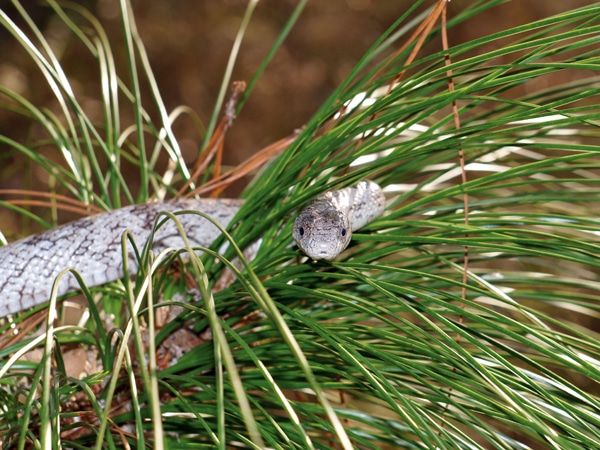Back in 1982, I was into collecting rat snakes and had assembled a Dream Team of specimens that was pretty impressive for the time. Back then, the acq
Back in 1982, I was into collecting rat snakes and had assembled a Dream Team of specimens that was pretty impressive for the time. Back then, the acquisition of different animals was much more difficult without the wide range of breeders and “one click, one buy” Internet options we have available today. I was in junior high school and required to give an oral presentation in my biology class, complete with visual aids. My report was about the rat snakes, and my mom brought several of my snakes to school for the presentation. The highlight was a 6-foot gray rat snake (Pantherophis [Elaphe] spiloides). This snake was obtained through a trade with the laboratory of the late Dr. Sherman Minton, Jr. The snake was wild caught and had been used as a control in blood test studies, so there I was, showing off a large, robust snake with a very bad attitude. It was accustomed to getting stuck with a needle pretty much every time it was handled, and because of that, “docile” and “gentle” were two words that were definitely not in that snake’s vocabulary. I did get an A on the report, however, complete with extra credit points for my live demonstration of severe arterial bleeding.
Read More
Breeding Trans-Pecos Rat Snakes
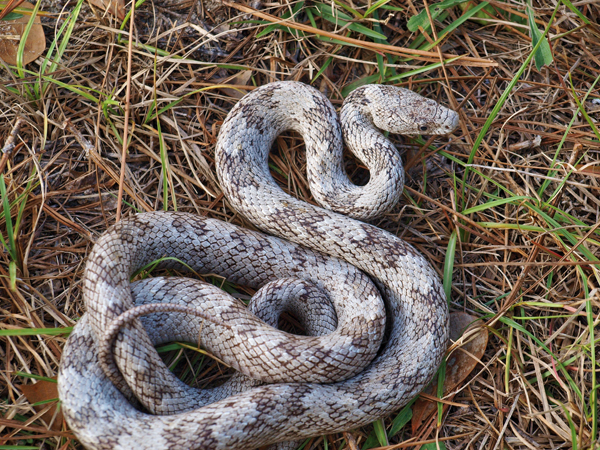
mike morgan
Pantherophis spiloides ranges in color, from nearly all dark with minimal blotch contrast to almost pure white.
Gray Rat Snake Description
The gray rat snake is a medium to large, heavily blotched snake found throughout the eastern and southern United States, as well as southeastern Canada. The adults retain the blotches that they are born with throughout their life. They belong to the same family as the black (P. obsoleta) and yellow (P. o. quadrivittata) rat snakes and interbreed with both where their ranges overlap.
The gray rat snake varies greatly in color throughout its range, from almost uniformly dark with a little blotch contrast, to almost pure white (this lighter phase is known as the “White Oak” phase). Their ground color is usually a dark to medium gray, with the blotches darker against the background. Sometimes the blotches on the top of the back are alternated with small black spots, or outlined with black. Two black stripes line the tail from the divided anal plate, and a gray crown on the head with two single narrow black stripes from the back of the eye to the angle of the mouth forms a spear point on the head, similar to that found on a corn snake (P. guttatus).
A cross section look at the body reveals that the gray rat snake has a flat bottom meeting the rest of the body at a strong angle, making their shape similar to a loaf of bread. This, combined with weakly keeled scales, allows the gray rat to be a potent climber. As an arbor worker, I have personally encountered gray rat snakes in trees as high up as 70 feet.
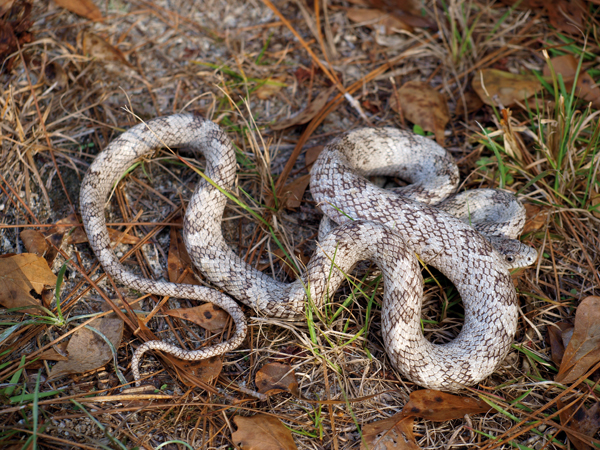
mike morgan
Gray rat snakes are found throughout the eastern and southern U.S., as well as southeastern Canada.
They are found in many different habitats throughout their range and are mostly diurnal in nature, but can become more nocturnal during the warmer months. Hatchlings range in size from 10½ to 17 inches, while adults average 42 to 72 inches. The record is 84¼ inches. Males grow longer and faster than females. The gray rat snake’s large size and diverse color varieties make it an interesting addition to our native snakes, as well as a good candidate to be kept as a pet.
The Right Gray Rat Snake Enclosure
The gray rat snake does well in captivity and is usually easy to keep. Its average lifespan in captivity is 15 years, with one individual reportedly living for 22 years. I’ve had good luck keeping trios of gray rat snakes in 55-gallon fish tanks, and single adults in 20-gallon long tanks. The more room these active snakes have to move and the less restricted they feel, the quicker they will adapt to their captive environment. A hide box is mandatory to provide security, and a sturdy branch to climb on can also be provided, although heavy-bodied adult snakes tend to remain on the ground.
Some gray rat snakes constantly prowl their cages. In such cases, watch for rostral rubbing that can lead to an infected wound. Smooth cage sides and a pegboard (or similar smooth material) top will help prevent injury to such restless snakes. A secure, escape-proof top is a necessity, of course.
The gray rat is hardy and can be successfully maintained at a temperature range of 69 to 82 degrees Fahrenheit. (I once captured one that was crossing a road during a December rainstorm in north Florida, when the temperature was 37 degrees.) An undertank heater or basking light set to the higher temperature and placed at one end of the enclosure will allow for a thermal gradient along which your snake can thermoregulate.
A water dish large enough for the snake to soak in is a must. Make sure it is stable enough not to overturn. I prefer a no-tip plastic dog food bowl over a heavy crock dish for ease of cleaning and disinfecting. Gray rat snakes like to spend time in their water bowls, so frequent checks and changes are required.
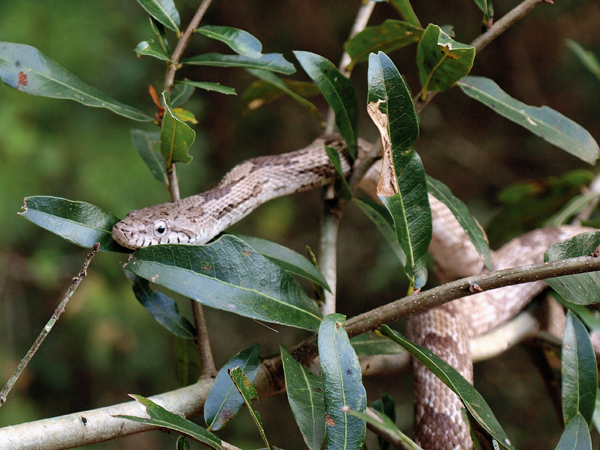
mike morgan
The gray rat snake is built for climbing; the author has encountered individuals as high as 70 feet in a tree.
Gray rat snakes, like other snakes, can be prone to shedding problems if the humidity in their enclosure is too low, and the ability to soak will help prevent this. On the opposite end of this spectrum, however, is their susceptibility to scale rot if they are kept too wet. A water bowl for soaking and the previously mentioned basking spot in the warm end of the enclosure—warm enough to allow the snake to dry thoroughly—will provide the range needed to keep your snake’s skin healthy.
For a substrate, I prefer newspaper because of its availability and ease of cleaning. Gray rat snakes are more active and messy than other snakes, such as boas and ball pythons, and newspaper allows for quick and easy changes. Other substrates such as aspen bedding will work, but because rat snakes are not burrowing snakes, they are really not necessary for anything other than a more natural appearance to the enclosure. Indoor/outdoor carpet has also been used successfully. In my opinion, ease of cleaning should be at the top of the list when picking any substrate. Lighting is not necessary, unless a basking light is used such as described above for heat.
Feeding Gray Rat Snakes
The gray rat snake is usually a voracious feeder on size-appropriate mammals and birds. Eggs will also be taken frequently. In the wild, rat snakes have been known to wipe out rodent populations and bird nests, eating the young that have not hatched.
One of my gray rat snakes was obtained one night after I received a phone call at 11 p.m. My neighbors had a sparrow nest in a plant basket on their front porch, and when they arrived home late that night they discovered a 2-foot-long gray rat snake swallowing the last chick in the nest. Although upset, they did not kill the snake and instead called me to retrieve it.
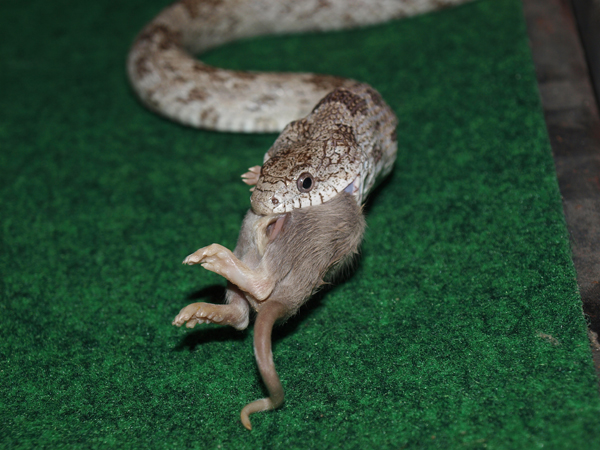
mike morgan
The gray rat snake is known for being a voracious eater of size-appropriate foods.
The gray rat snake’s ravenous attitude toward prey can be both a bane or a boon for farmers within the snake’s range. It helps to keep the harmful rodent population under control in areas where grain is harvested, providing an economic benefit to the farmer. But on the other hand, the snake’s love of birds and eggs can be detrimental to farmers who raise fowl. Another in my collection was found in a coop swallowing a baby goose.
When I interrupted this snake’s lunch, the goose was regurgitated. It was an older snake and in bad shape—scarred up, skinny and looking worn out. I brought it home, and though I usually give a wild-caught snake a week or two to acclimate before offering food, I tried offering a small rat to it the next day. After about five seconds and a couple of tongue flicks, the snake seized the rat and swallowed it. There was no strike and no constriction—the snake just gently grabbed the rat and ingested it. It was as if it had been in captivity its whole life and was used to being fed from forceps. Now, over a year later, he is the picture of health.
Some wild-caught snakes can present some problems when first brought into captivity. Though they may be feisty at first, gray rat snakes are usually tractable and lose the “rat snake” attitude quickly. In my experience, handling them off of hooks offers better results than reaching into the enclosure and picking them up. Hook them out of the enclosure first, and then handle them off the hook. This way, they don’t feel as defensive and become accustomed to handling quicker. Another method I have had good luck with is placing one in a snake bag and handling it through the bag. The lack of a visual stimulus cuts down on the snake’s fight-or-flight response—and it’s usually “fight” with gray rat snakes—and allows it to become more responsive to handling.
Sometimes, however, a snake will remain nervous and not simmer down. It may also refuse to feed, and if that happens, here’s a trick you can try: Cut a hole in the side of a small box with a lid, up toward the top, that is just barely large enough for the snake to enter. Place two or three pinkies or fuzzies (rat or mouse) inside the box with some bedding from the rodent cage. These should be a bit smaller than the prey items you usually offer the snake. The box simulates a rodent burrow, and eating inside it may feel more natural to a prowling snake that is looking for prey. I have had good luck feeding racers and whipsnakes using this method, and those snakes tend to be more ADHD than even the most spastic gray rat snake. Most of the time, though, resorting to this trick is not necessary, as gray rat snakes typically adapt quickly and will feed readily on appropriately sized rodents.
Breeding Gray Rat Snakes
The gray rat snake is relatively easy to breed in captivity, very similar to corn snakes. They reach sexual maturity at about 2 years old, and usually mate in mid-April to early June, with the most activity in late April to May. Some snakes in the southern states can breed during the winter, with corresponding laying times.
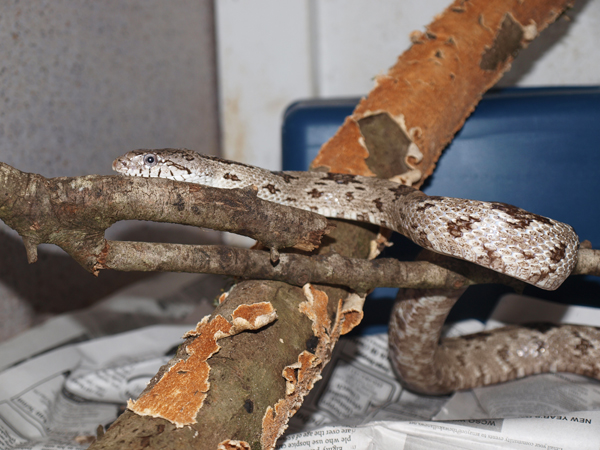
mike morgan
Branches make great additions to enclosures for these active snakes.
A rack system can be set up for juveniles and subadults, though I have better luck keeping breeding adults in larger cages. Although gray rat snakes are fairly easy to breed, there are some tricks to help them along.
Brumating them for 50 to 70 days at a temperature of 45 to 59 degrees will allow normal gamete formation. Make sure the snakes’ last meal has been completely digested and excreted before you begin cooling them gradually. If there is undigested food remaining in their system serious problems could result from the lowered temperature and slowed metabolism. Keep water available during brumation and try to disturb the snakes as little as possible.
When the weather warms, gradually warm the snakes up to their normal temperatures over a couple of weeks. Be sure they are eating before placing them together for breeding. I introduce the female into the male’s enclosure. Be sure the cage is large enough for the snakes to stretch out while breeding; confined quarters can sometimes hamper the courting efforts of the male.
If no breeding activity is observed, try placing a shed skin from the female into the male’s enclosure. A paste made from water mixed with the female’s uric acid (the white part of the excrement) can be applied to the female’s back prior to introducing her to the male, as well. Both of these techniques are believed by some breeders to help stimulate a male into breeding. Several males can also be put together to encourage territorial disputes. In the wild, males will combat dance, so keep an eye on them to prevent any serious fights.
Hopefully, a successful breeding will take place. Now it is time to get ready for the eggs. The female will need a lot of water at this time, so keep plenty of fresh water available. She will usually continue to eat until the middle to last third of a 37- to 51-day gestation period. Keep an egg box in the cage to allow for natural nesting behavior. I use a plastic shoe box with a lid, with a 2- to 3-inch layer of peat moss or vermiculite inside. Just cut a hole in it for access and the female will find it. Having a secluded place to lay her eggs will keep her calmer and help prevent egg binding. Also, if the eggs happen to be laid when you aren’t there to remove them right away, having them laid in an egg box will prevent them from being knocked about the enclosure. The box containing the eggs can then be removed to facilitate the eggs’ transfer to an incubator. The egg-laying process takes a toll on the female, so after she lays be sure to feed her immediately and often to get her strength back up.
Five to 44 eggs may be laid. Remove the eggs from the egg box and incubate them at 75 to 80 degrees on a substrate of vermiculite or similar medium. Incubation duration averages about 60 to 75 days. The babies should be separated after hatching, and a shoebox rack system works well for housing them. The smaller water containers necessary for such small enclosures tend to evaporate quickly, so constant monitoring will prevent any potentially fatal dehydration.
After the babies’ first shed, small pinkie mice can be offered. Most of the time these will be taken with no problems, but some babies can be finicky. In that case, small lizards (Anolis spp.) or tree frogs (Hyla spp.) can be offered. Tree frogs are particularly relished by baby gray rat snakes, and even the most stubborn feeders will usually take them. If it becomes necessary to use these alternative food items, freeze some and use them to scent the pinkies.
Gray Rat Snake Morphs
So why breed such a common snake, and one that many people consider a “junker?” In the words of one of my friends, “The only thing gray rat snakes are good for is king cobra food.”
Even haters such as my friend cannot deny that some gray rat snakes are downright beautiful. The White Oak phase is one of these. The Apalachicola region of northwest Florida also produces a color phase that has a calico pattern with random mottling that is called the “Malt.” This color phase is also being bred in captivity.
Along the western coast of Florida there exists a snake called the Gulf Hammock rat snake. It was once considered a subspecies named Elaphe obsoleta williamsi, although now it is thought to be a cross between the gray and yellow rat snakes. The Gulf Hammock rat snake resembles the gray rat snake, but it has four lines running down its back that connect the blotches, producing a ladder effect. I have seen this snake available, under the name, “Jigsaw.”
All the P. obsoleta interbreed in the wild, which leads to some exciting possibilities. Crossing the gray rat snake with the different phases of the black rat snake, such as the albino, or crossing it with some of the cleanly striped yellow or Everglades specimens, could produce some interesting colors and patterns. And this would not be hybridizing per se, as this occurs naturally.
Also, some of the prettier color morphs could be selectively bred, to see where that goes genetically. Gray rat snakes have been successfully bred with the corn snake, producing a “Frosted Creamsicle” when crossed with the albino corn snake gene. I believe that the gray rat snake is an overlooked species, and with all the high-end, exotic morphs available today, I find it inspiring that such a diverse snake exists right in my own backyard. For someone willing to take the time, the gray rat snake, with its beautiful natural color phases and low maintenance requirements in captivity, could provide an interesting project to pursue.
Mike Morgan got his first snake in 1973, when he was 5 years old. He has since collected and kept many reptiles native to the U.S., as well as many exotic species in several collections, institutions and shops. He can be reached at mmor7@hotmail.com.

